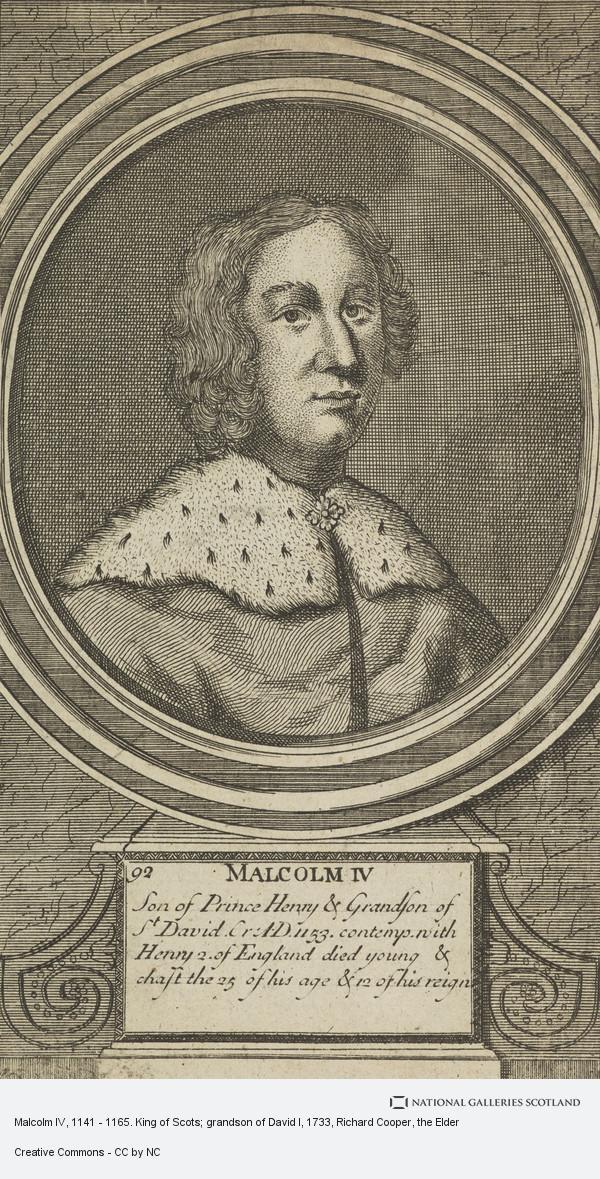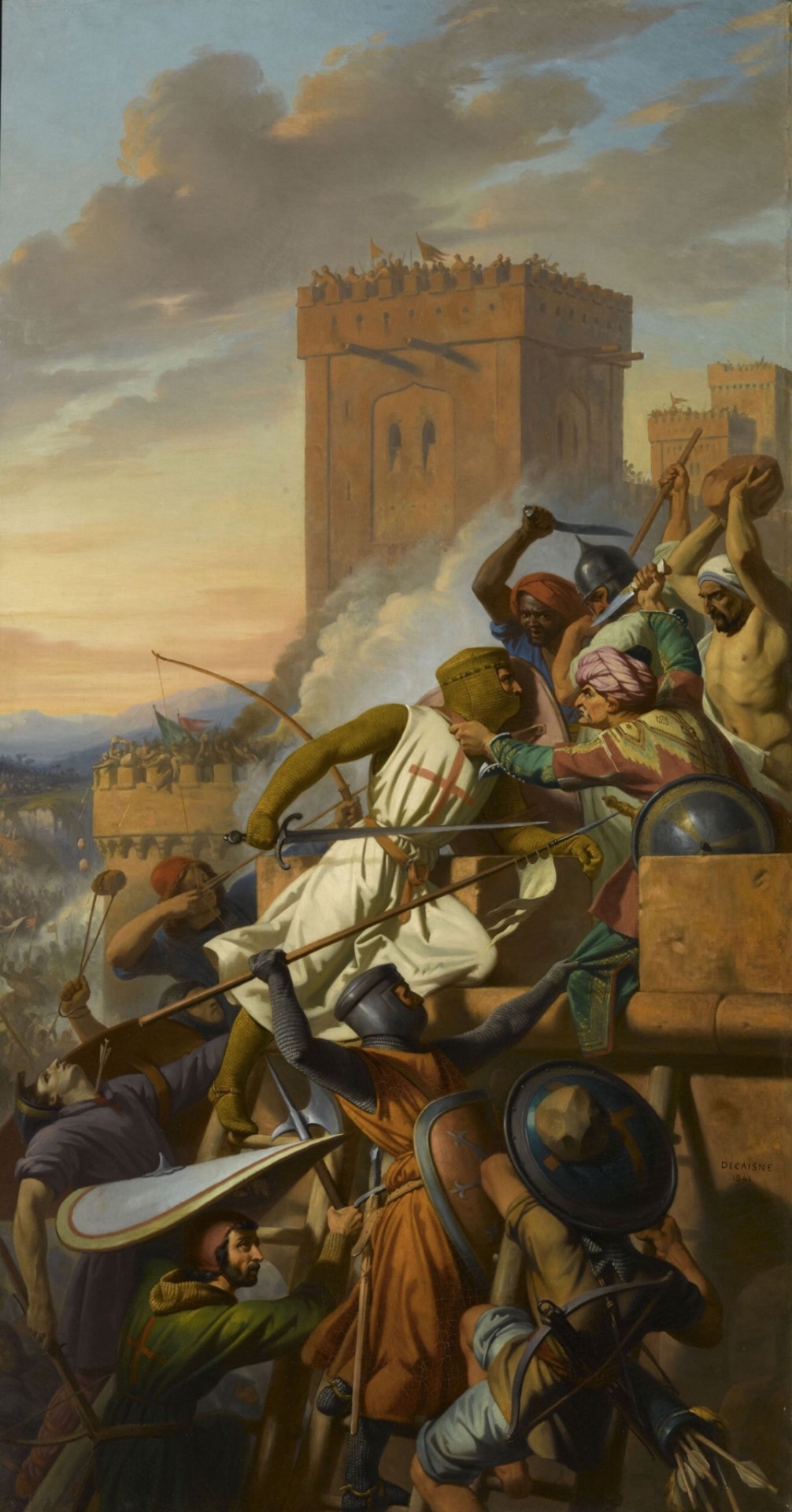#siege of toulouse
Text

The Death of Simon de Monfort by Ramon Acedo
#simon de monfort#siege of toulouse#art#ramon acedo#albigensian crusade#toulouse#medieval#middle ages#crusades#crusaders#knights#knight#crusade#crusader#history#cathar#cathars#languedoc#occitania#occitanie#france#europe#european#heraldry#mangonel#stone#despertaferro magazine#ramón acedo
176 notes
·
View notes
Text
Today June 25th in 1218AD the French leader of the Albigensian Crusade, Simon De Montfort the elder was killed at the siege of Toulouse. His head was smashed in by a stone fired from a mangonel.

60 notes
·
View notes
Text

December 9th 1165 saw the death of our King, Malcolm IV aged just 24.
Malcolm was crowned king in 1153 at the age of twelve. He was a pious young man and very interested in chivalry and warfare. He also had Anglo-Norman tastes which did not endear him to the Scottish people and he had to face a number of uprisings during his reign. He became known as Malcolm the Maiden partly because of his vow of celibacy.
Malcolm held the earldom of Northumbria and paid homage to King Henry II of England for his lands there. In 1157 he surrendered his northern English counties in return for the earldom of Huntingdon. It was a bad deal for the Scottish king but he desperately wanted to be knighted by Henry II and perhaps feared a war.
In 1159 Malcolm accompanied the English king to France and took part in the siege of Toulouse an act for which he was finally knighted. However upon returning home in 1160 the king had to face a revolt which ended with him subduing Galloway. He then turned his attention to Moray in the north and finally to the King of the Isles, Somerled in the west. It seems many of the Scottish nobles were irritated by his neglect of the kingdom and angered by his deference to the English king.
Malcolm was only twenty-four when he died, apparently of natural causes, in 1165 and he left no heirs. He was buried in Dunfermline Abbey and was succeeded by his brother William, the Lion who would try and regain the lands his brother surrendered.
Lots more on Malcom at the ever reliable Rexfactor site https://rexfactor.wordpress.com/.../06/malcolm-iv-1153-65/
9 notes
·
View notes
Photo

The Battle of Ascalon took place on 12 August 1099 shortly after the capture of Jerusalem, and is often considered the last action of the First Crusade.[7] The crusader army led by Godfrey of Bouillon defeated and drove off a Fatimid army, securing the safety of Jerusalem.[8]
The Crusaders completed their primary objective of capturing Jerusalem on 15 July 1099. In early August, they learned of the approach of a 20,000-strong Fatimid army under vizier al-Afdal Shahanshah. Under Godfrey's command the 10,200-strong Crusader army took the offensive, leaving the city on 10 August to risk everything on a great battle against the approaching Muslims. The Crusaders marched barefoot, carrying the relic of the True Cross with them, accompanied by patriarch Arnulf of Chocques. The army marched south from Jerusalem, approaching the vicinity of Ascalon on the 11th and capturing Egyptian spies who revealed al-Afdal's dispositions and strength. (The distance from Jerusalem to Ascalon is about 77 km)
At dawn on 12 August, the Crusader army launched a surprise attack on the Fatimid army still sleeping in its camp outside the defensive walls of Ascalon. The Fatimids had failed to post enough guards, leaving only a part of their army capable of fighting. The Crusaders quickly defeated the half-ready Fatimid infantry, while the Fatimid cavalry barely fought at all. The battle was over in less than an hour. The Crusader knights reached the center of the camp, capturing the vizier's standard and personal baggage, including his sword. Some Fatimids fled into the trees and were killed by Crusader arrows and lances, while others begged for mercy at the Crusaders' feet and were butchered en masse. The terrified vizier fled by ship to Egypt, leaving the Crusaders to kill any survivors and gather up a vast amount of loot. Ibn al-Qalanisi estimated 12,700 Fatimid dead.[9]
The first Muslim attempt to recapture Jerusalem ended in complete defeat, but Godfrey failed to exploit the victory and take Ascalon, whose Fatimid garrison was willing to surrender only to Raymond of Toulouse, a condition Godfrey would not accept. The Fatimid base in Ascalon remained a thorn in the side of the Kingdom of Jerusalem and would not fall until the siege of Ascalon of 1153.
https://en.wikipedia.org/wiki/Battle_of_Ascalon
2 notes
·
View notes
Text
PSG-Star Mbappé ist über die Zukunft nach der laufenden Saison unentschlossen
Kylian Mbappé gab am Mittwoch bekannt, dass er noch keine Entscheidung über die Verlängerung seines Vertrags mit Paris Saint-Germain (PSG) über die laufende Saison hinaus getroffen hat, sodass die Möglichkeit eines ablösefreien Abgangs im Sommer offen bleibt. Obwohl sein Vertrag nur noch sechs Monate läuft, hat PSG seine Bereitschaft gezeigt, Angebote anzunehmen. Le Parisien berichtet, dass Liverpools Führung gemeinsam mit dem Dauerbewerber Real Madrid aktiv „seine Situation überwacht“. Das Interesse von Liverpool und Real Madrid an Mbappé fügt der Erzählung eine faszinierende Ebene hinzu, mit der Möglichkeit, dass er seine vertrauten PSG trikot gegen ein neues Fußballkapitel eintauscht.
Mbappés vertragliche Zukunft ist angesichts der außergewöhnlichen Ereignisse rund um seinen möglichen Wechsel zu Real Madrid im Juni 2022 von Ungewissheit geprägt. Sogar der französische Präsident Emmanuel Macron intervenierte, um ihn zu diesem Zeitpunkt davon zu überzeugen, bei PSG zu bleiben. Der Stürmer löste in Frankreich breite Reaktionen aus und trotz früherer Erwartungen hat er sich noch nicht zu einer Vertragsverlängerung verpflichtet. Während Mbappé über seine Zukunft nachdenkt, wächst die Möglichkeit, ihn in der nächsten Saison in einem anderen Satz günstige fußballtrikots zu sehen, was die Intrigen rund um seinen möglichen Abgang von PSG noch verstärkt.
Nachdem Mbappé zum 2:0-Sieg von PSG über Toulouse in der Champions Trophy beigetragen hatte, betonte er, dass er sich derzeit auf die laufende Saison konzentriere. Er brachte seine Motivation für das kommende Jahr zum Ausdruck und betonte, wie wichtig es sei, mit PSG weitere Titel anzustreben und zu sichern.
Mbappés Vertragshistorie macht die Situation noch komplexer, da er angeblich im Jahr 2022 einen Dreijahresvertrag unterzeichnet hatte. Spätere Enthüllungen stellten jedoch klar, dass es sich um einen Zweijahresvertrag handelte, wobei ein drittes Jahr von Mbappés Aktivierung abhängig war. Die Vereinbarung enthält wahrscheinlich eine Ausstiegsklausel in Höhe von 100 bis 150 Millionen Euro, die sicherstellt, dass PSG bei seinem eventuellen Abgang eine Ablösesumme erhalten kann.
Nachdem er 2017 von Monaco zu PSG wechselte, ist Mbappé der beste Torschütze des Vereins aller Zeiten und kann auf fünf Ligue-1-Titel zurückblicken. Da PSG die Tabelle der Ligue 1 mit fünf Punkten Vorsprung anführt, trifft der Stürmer im Achtelfinale der Champions League auf Real Sociedad.
0 notes
Text










Camaret-sur-Aigues, France (No. 9)
During the 19th century, excavations uncovered cash, funerary urns, oil lamps, so-called lachrymatory vessels and polished silver mirrors. An epigraph tombstone embedded in the façade of a house had been unsealed and sold. It bore the inscription S. P. SEVERIUS SIBI ET SVIS VIVUS FECIT. Remains of an aqueduct that supplied Orange with spring water had also been identified16.
During the twentieth century, more scientific excavations led to the discovery of a fragment of an epigraph altar in the Hopscotch district, and three tegulæ burials on the site of the Garriguettes.
Throughout the late Middle Ages and until the Revolution, Camaret depended on the barony of Sérignan. It had first belonged to the Principality of Orange since Raymond VII of Toulouse, Count of Provence, had given it as a fief, in 1237, to Raymond des Baux. This fief was given as a dowry to Tiburge of Orange on her marriage to Adhémar de Poitiers, Count of Valentinois. In 1324, the latter granted the election of two syndics to represent the community. Their successors, on 7 May 1416, signed a price for the construction of new ramparts.
The knight Guillaume Fabri was co-lord of Camaret-sur-Aigues until he was condemned to the chapter of Lattes18. In 1346, it was the former baile of Pélissanne (1345), Raymond Martini, who was commissioned to sell his possessions. Around 1346, William of Orange was lord of Camaret and Sérignan. Noble and powerful, Jean de Baux, lord of Camaret and Sérignan, had in his service as ordinary judge of his two lands, in 1369, a noble bachelor, originally from Orange, Bérenger Sadoyrani, judge of Arles (1372) and of Sisteron (1387).
In 1495, the Town Council obtained permission from the barony that each inhabitant could cultivate a tithe-free garden on fruit and pasture.
The Wars of Religion raged for a decade. Camaret having been taken by the religionists, January 5, 1563, the papal captain Fabrice Serbelloni came to lay siege. After four days of cannonade, his troops invested the village and put 100 prisoners to the sword. A new attack by the Calvinists of Nyons took place in 1573. But their henchman who was to open the doors for them was unmasked and they withdrew. This was not the case two years later. On 3 May 1575, the Huguenots of Orange forced their way into the place, but were soon forced to retreat in the face of the troops sent by Cardinal d'Armagnac.
These attacks have made it possible to know that in 1565, the ramparts opened by three gates: the Great Gate or Berenguier Gate, also known as the Ursuline Gate; the Porte Jaubert or Portalet; the Carbonnel Gate. Those of Le Portail and Carbonnel were preceded by a drawbridge. When the fighting was over, two other gates were opened, the Breach and the Tower.
It was in 1599 that the two syndics of the village changed their title to that of consul.
Source: Wikipedia
#Camaret-sur-Aigues#Porte Carbonnel#Provence-Alpes-Côte d'Azur#Vaucluse#Carpentras#Vaison-la-Romaine#summer 2021#France#Europe#travel#original photography#vacation#tourist attraction#landmark#architecture#cityscape#small town#village#flora#fauna#evening light#Grand Rue#moon#clouds
1 note
·
View note
Text
Events 10.21 (before 1950)
1096 – A Seljuk Turkish army successfully fights off the People's Crusade.
1097 – First Crusade: Crusaders led by Godfrey of Bouillon, Bohemund of Taranto, and Raymond IV, Count of Toulouse, begin the Siege of Antioch.
1392 – Japanese Emperor Go-Kameyama abdicates in favor of rival claimant Go-Komatsu.
1512 – Martin Luther joins the theological faculty of the University of Wittenberg.
1520 – João Álvares Fagundes discovers the islands of Saint Pierre and Miquelon, bestowing them their original name of "Islands of the 11,000 Virgins".
1600 – Tokugawa Ieyasu defeats the leaders of rival Japanese clans in the Battle of Sekigahara and becomes shōgun of Japan.
1774 – The flag of Taunton, Massachusetts is the first to include the word "Liberty".
1797 – In Boston Harbor, the 44-gun United States Navy frigate USS Constitution is launched.
1805 – Napoleonic Wars: A British fleet led by Lord Nelson defeats a combined French and Spanish fleet under Admiral Villeneuve in the Battle of Trafalgar.
1824 – Portland cement is patented.
1854 – Florence Nightingale and a staff of 38 nurses are sent to the Crimean War.
1861 – American Civil War: Union forces under Colonel Edward Baker are defeated by Confederate troops in the second major battle of the war.
1867 – The Medicine Lodge Treaty is signed by southern Great Plains Indian leaders. The treaty requires Native American Plains tribes to relocate to a reservation in the western Indian Territory.
1879 – Thomas Edison applies for a patent for his design for an incandescent light bulb.
1888 – The Swiss Social Democratic Party is founded.
1892 – Opening ceremonies for the World's Columbian Exposition are held in Chicago, though because construction was behind schedule, the exposition did not open until May 1, 1893.
1895 – The Republic of Formosa collapses as Japanese forces invade.
1907 – The 1907 Qaratog earthquake hits the borders of Uzbekistan and Tajikistan, killing between 12,000 and 15,000 people.
1910 – HMS Niobe arrives in Halifax Harbour to become the first ship of the Royal Canadian Navy.
1912 – First Balkan War: The Greek navy completes the capture of the island of Lemnos for use as a forward base against the Dardanelles.
1921 – President Warren G. Harding delivers the first speech by a sitting U.S. president against lynching in the Deep South.
1931 – A secret society in the Imperial Japanese Army launches an abortive coup d'état attempt.
1940 – The first edition of the Ernest Hemingway novel For Whom the Bell Tolls is published.
1943 – World War II: The Provisional Government of Free India is formally established in Japanese-occupied Singapore.
1944 – World War II: The first kamikaze attack damages HMAS Australia as the Battle of Leyte Gulf begins.
1944 – World War II: The Nemmersdorf massacre against German civilians takes place.
1944 – World War II: The city of Aachen falls to American forces after three weeks of fighting, the first German city to fall to the Allies.
1945 – In the 1945 French legislative election French women vote for the first time.
0 notes
Text
You are in the middle of the First Crusade, Siege of Jerusalem (1099 CE)
As you look out from behind the walls of Jerusalem, you can see the Christian armies of the First Crusade camped outside the city. They are led by Godfrey of Bouillon, Raymond of Toulouse, Robert Curthose, Bohemond of Taranto, and other renowned knights.
You can also see that the army of Jerusalem led by Iftikhar al-Dawla is vastly outnumbered. You estimate that there are at least 20,000…

View On WordPress
#Battle#BohemondofTaranto#ChristianArmy#ChristianKnights#FirstCrusade#GodfreyofBouillon#HistoricMoments#Iftikhara#Jerusalem#MedievalHistory#MiddleEastTensions#MuslimDefenders#MuslimSoldiers#RaymondofToulouse#RobertCurthose#TragicOutcomes#al-Dawla
0 notes
Text
혜미리예채파 6회 다시 보기 6화 E06 (ENA)
혜미리예채파 6회 다시 보기 6화 E06 (ENA) 링크<<

혜미리예채파 6회 다시 보기 6화 E06 (ENA)
혜미리예채파 6회 다시 보기 6화 E06 (ENA)
혜미리예채파 6회 다시 보기 6화 E06 (ENA)
혜미리예채파 6회 다시 보기 6화 E06 (ENA)
혜미리예채파 6회 다시 보기 6화 E06 (ENA)
At the beginning of the first episode, Kou and his friends, who are having a succession ceremony, announce that they are the new Ryusoulgers, and right after that, they feel a strange aura and inform the Ryusoulers that Druden has returned. That night, he expelled Tatsui Ui, who secretly fo혜미리예채파 6회 다시 보기 6화 E06 (ENA)llowed Kou, to erase his memory and send him out of the village. The next day, after the battle, he appears and tells him to find his comrades who left the village in the past and carry on the will of the masters.
After a long time, he reappears in episode 6. Because the entire village was destroyed by the Dragon Miner Soar and he had nowhere to go, he got a food truck혜미리예채파 6회 다시 보기 6화 E06 (ENA) and was selling kebabs. He analyzes Cerberus Minor Soar's fangs and creates an antidote for Cerberus Minor Soar's poison.
After that, there is no appearance or mention, but it seems that it is because after the destruction of the temple and the village, I became interested in ties and exchanges with humans, which I had not originally done while selling kebabs, and fell in love with them.
After a long time, it reappeared in episode 34. He was doing business by setting up a cafe with Otto. As an aside, the shape of the arrow is also similar to Ultraman Jack's weapon Ultra Lance.
Appeared after a long time at the end of the final episode. He wanted to give Kou serious advice, saying that human beings are always repeating failures, but it turned out that he had been involved in a fitness club and overdon혜미리예채파 6회 다시 보기 6화 E06 (ENA)e his business. Eustace, son of Eustace II, Count of Boulogne The three brothers, Godfrey and Baldwin, participated in the First Crusade, and Baldwin was honored as a lord in Edessa on the way and established the county of Edessa, and Eustace III, who inherited Boulogne from his father, returns to his territory.
In 1099, the Crusaders successfully captured Jerusalem and recaptured the Holy Land. Emperor Alexios I of the Eastern Roman Empire made the crusader commande혜미리예채파 6회 다시 보기 6화 E06 (ENA)rs take an oath of allegiance, and according to principle, they had to give up the occupied lands. and the question of who would be king of Jerusalem arose. Raymond, count of Toulouse, who was the leader, was first invited to be king, but he refused, and Godfrey, who opened the gates during the siege of Jerusalem, was nominated. Godfrey avo혜미리예채파 6회 다시 보기 6화 E06 (ENA)ided controversy by using the title 'Guardian of the Holy Sepulchre' instead of King.
Godfrey died suddenly without children in 1100, while continuing the battle with the surrounding Muslim powers, and Daimbert da Pisa, Patriarch of Jerusalem, tried to dedic혜미리예채파 6회 다시 보기 6화 E06 (ENA)ate Jerusalem to the papacy. However, the crusader lords, who did not intend to follow this, appoint Godfrey's younger brother, Baldwin. Baldwin left Edessa to his maternal relative Baldwin de Letel, inheriting his brother's title and formally becoming King of the Kingdom of Jerusalem. He joined forces with subsequent crusaders to expand his territory b혜미리예채파 6회 다시 보기 6화 E06 (ENA)y attacking the Muslims of the Levant and the Fatimid dynasty of Egypt, but died of food poisoning in 1118 without an heir. Among the children of Hugues I de Rethel, the 4th lord of Rethel There was Baudouin de Rethel, but he could not inherit the manor because he had his eldest son, 혜미리예채파 6회 다시 보기 6화 E06 (ENA)Manasseh. At that time, the crusade movement shook all of Europe, and when three relatives from the outskirts participated in the first crusade, they intervened together. The three were Eustace, Godfrey, and Baldwin.[1] With them, he reached the Anatolian Peninsula and followed Baudouin de Flanders, who was heading to Edessa at the for혜미리예채파 6회 다시 보기 6화 E06 (ENA)k in the road to Antioch. Later, when Baldwin de Flanders was nominated as the 2nd King of Jerusalem and left for Jerusalem, Baldwin de Letel was appointed as the 2nd lord of the county of Edessa. As the third king, he is appointed by the parliament. In fact, Eustace, the eldest brother of King Baldwin I, who had returned to Europe, was on his way to the Holy Land to inherit the king's will, but he snatched the throne by some trick.
The Rethel family became king of the Holy Land Kingdom of Jerusalem, but Baldwin married a local Edessa aristocratic woman named Morfia Malatiachi, and, as luck would have it, gave birth to three daughters. The eldest daughter was M혜미리예채파 6회 다시 보기 6화 E06 (ENA)elisande, and she got Fulk as her son-in-law, but the family stopped there. Ironically, as if that fate was unavoidable, the Letel family in Europe's home country also had a paternal line, ending with Baldwin's younger sister, Mathilde.
0 notes
Photo

ACTION XR AU SIEGE DE PERRE FABRE A LAVAUR "A69 – PIERRE FABRE : TON GREENWASHING NE LAVERA PAS TES MAINS SALES" Action Extinction Rebellion au Siège de Pierre Fabre pour manifester contre l’autoroute A69. France, Lavaur on February 18, 2023 @xr_toulouse / ➡️ #AbacaPress #Abaca #Photographie #presse ➡️ #XR #ExtinctionRebellion #Lavaur #PierreFabre #Action #A69 #photographie #femmephotographe #photodocumentaire #press #photographie #leicawomenfotoproject #leicawomen #myleicaphoto #femmes #photojournalisme #Autoroute #castres #toulouse #redRebels 📸 photo @patricia.huchot_boissier / @_abaca_ Série disponible sur #PixPalace & #Reuters https://linktr.ee/p.huchotboissier (à Lavaur, Midi-Pyrenees, France) https://www.instagram.com/p/Co2wQpljC6-/?igshid=NGJjMDIxMWI=
#abacapress#abaca#photographie#presse#xr#extinctionrebellion#lavaur#pierrefabre#action#a69#femmephotographe#photodocumentaire#press#leicawomenfotoproject#leicawomen#myleicaphoto#femmes#photojournalisme#autoroute#castres#toulouse#redrebels#pixpalace#reuters
0 notes
Text
Darkly funny historical fact:
Simon de Montfort, leader of the Second Barons’ Revolt in Britain, was French-born. His father, also called Simon de Montfort, was beheaded.
By a rock fired from a mangonel during the siege of Toulouse, 1217-18.
0 notes
Text

Taking of the fortress of Maarat by the Crusaders in 1098
Capture of the fortress of Maarat in the province of Antioch in 1098 by Henri Decaisne
#the first crusade#first crusade#siege of maarat#syria#crusaders#crusades#medieval#history#knights#art#henri decaisne#siege#bohemond of taranto#castle#christians#ma’arrat al-numan#city#raymond iv of toulouse#raymond de toulouse#bohemond#robert ii of flanders#chevaliers#european#europe#christendom#muslims#crusade#knight#crusader#fortress
50 notes
·
View notes
Text
youtube
Cannibalism in the first Crusade
#cannibalis#1st Crusade#Crusades#cannibalism#1st crusade#crusades#siege of antioch#Peter de Hermit#nicea#jerusalem#seljucks#Fatımids#Stephen of blois#Raymond IV of Toulouse#Battle of Ascalon#battle#medieval#templars#Tripoli#Acre#Godfrey of Bouillon#Baldwin of Boulogne#The First Crusade (1096–1099)#Byzantine emperor Alexios I Komnenos#Pope Urban II#Battle of Civetot#People's Crusade#Peasant's Crusade#Youtube
0 notes
Text

On March 20th 1141 King Malcolm IV was born, possibly in Forfar.
Malcolm IV was crowned 27 May 1153 at Scone at age twelve. He was a pious young man and very interested in chivalry and warfare. He also had Anglo-Norman tastes which did not endear him to the Scottish people and he had to face a number of uprisings during his reign. He became known as Malcolm the Maiden partly because of his vow of celibacy.
Malcolm held the earldom of Northumbria and paid homage to King Henry II of England for his lands there. In 1157 he surrendered his northern English counties in return for the earldom of Huntingdon. It was a bad deal for the Scottish king but he desperately wanted to be knighted by Henry II and perhaps feared a war.
In 1159 Malcolm accompanied the English king to France and took part in the siege of Toulouse an act for which he was finally knighted. However upon returning home in 1160 the king had to face a revolt which ended with him subduing Galloway. He then turned his attention to Moray in the north and finally to the King of the Isles, Somerled in the west. It seems many of the Scottish nobles were irritated by his neglect of the kingdom and angered by his deference to the English king.
Malcolm was only twenty-four when he died, apparently of natural causes, in 1165 and he left no heirs. He was buried in Dunfermline Abbey and was succeeded by his brother William.
The pic shows detail from the charter of Malcolm IV, King of Scotland to Kelso Abbey and shows Malcolm sitting to the right of his Grandfather King David I.
11 notes
·
View notes
Text
“Military diplomacy was another area of war where noblewomen sometimes took a leading role. The term ‘diplomacy’ in this case refers to negotiations undertaken either to find peace between two warring sides or in order to forge an alliance. Many noblewomen had a significant role to play in the diplomatic process and an interest in successfully completing the negotiation process. However, the limited military role most noblewomen enjoyed meant that in practise female diplomacy in the Middle Ages was affected only by royal, or other similarly highly placed women whose importance, symbolic or otherwise, compelled their inclusion in the negotiations.
Several instances of diplomacy stand out in this regard. During the Investiture Controversy, for example, Matilda of Tuscany pursued diplomacy alongside her military support of the reform papacy. At the Lenten Synod in 1075 she tried to ease tensions in a bitter dispute between Gregory and Censius Stephani, a noted enemy of the reform papacy, by calling for clemency on Censius’ behalf, after he was arrested and sentenced to death. The following year at the Synod of Worms Matilda and Pope Gregory were accused by the Emperor Henry of an overly intimate and improper sexual relationship. Matilda and the pope responded by toning down the frequency of their correspondence and thenceforth only communicating through legates, thus stifling any further allegations of misconduct and illustrating a diplomatic solution by Matilda to another potential source of conflict.
Most well- known of all were Matilda’s efforts in negotiating a truce between pope and emperor at her castle of Canossa in January 1077. The fortress itself and the protection offered by her troops undoubtedly encouraged Gregory to meet with the emperor when he otherwise would not have; moreover, Matilda’s personal efforts to convince the pope to receive Henry after his three day penance outside the gates and her sponsoring of the final agreement played a major part in achieving a peaceful accord.
Noblewomen were also diplomatically active in the French and Anglo- Norman domains. Adela of Blois (c.1067-1137), countess of Blois, Chartres, and Meaux, was known for her efforts in reconciling a conflict between Anselm, Archbishop of Canterbury, and King Henry I in 1104, by arranging a face-to-face negotiation that resulted in their eventual reconciliation. Adela was also active in creating an Anglo-Norman-Thibaudian alliance against Louis VI in the early 1110s, after he threatened Thibaudian autonomy in the Chartrain by revoking castle-building privileges and claiming certain ecclesiastical properties. A few years later Adela played a pivotal role in helping King Henry I’s negotiator Thurstan (Archbishop of York) reach a favourable settlement resolving Henry’s dispute with King Louis.
Blanche of Castile (1188-1252) was likewise active in negotiating treaties that helped to ensure royal power in the north of France while ruling as regent for her son, Louis IX. Among the more notable agreements were the 1229 Treaty of Paris-Meaux between Louis IX and Raymond VII of Saint-Gilles, count of Toulouse, which brought an end to the Albigensian Crusade, and the 1242 Peace of Lorris that essentially confirmed the terms of the 1229 treaty and ended any chance of southern France remaining independent from royal authority. The importance of Blanche’s role in both cases is worth noting: in 1229 Blanche was still regent (Louis’ personal government did not begin until around 1236) and thus her acceptance of the treaty was significant, even though she did not personally negotiate the actual conditions of the treaty, while in 1242 Raymond had Blanche act as an intermediary on his behalf in achieving a final peace with the king.
In England, the Countess Mabel, Robert of Gloucester’s wife, held King Stephen in captivity after his capture at the Battle of Lincoln in 1141, which enabled Robert to bargain for his release after he had himself been captured by Stephen’s forces during the same battle. For her part, Stephen’s wife Matilda of Boulogne was simultaneously active in negotiating her husband’s release.
In the Holy Land noblewomen were also at times an important part of the diplomatic process. Baldwin II’s wife, Morphia, was said by Orderic to have been active in the negotiations for Baldwin’s release from captivity in 1124. Likewise, when in 1152 Queen Melisende found herself under siege in Jerusalem by her own son Baldwin III, who was fighting her for control of the Latin kingdom, she was able – through the mediation of the Church – to secure the city of Nablus and surrounding lands to which she could retire. Evidently, her sixteen years as ruler must have counted for something in the negotiations with Baldwin, for she was able to emerge just a few years later to a position of relative power and freedom in Baldwin’s government.
Occasionally, women in the Holy Land were even said to have attempted diplomacy with Muslims. According to William of Tyre, Melisende’s sister, Alice of Antioch, attempted to send an alleged peace offering to the Muslim leader Zengi, as part of her efforts to gain control of Antioch in the early 1130s, but was unsuccessful. Asbridge has cautioned against accepting the testimony of William of Tyre too uncritically, as no contemporary Muslim accounts mention this offer of peace.
Similarly unclear is the role played by Queen Marguerite (c.1221-1295), wife of Louis IX, whom Louis’ biographer Jean de Joinville portrayed as a dignified, pious, and thoughtful noblewoman, and who was mentioned during the course of Louis’ negotiations with the Saracens following his capture at the battle of Mansourah in April 1250. According to Joinville, the king could not guarantee to his captors that he could pay their ransom because he would have to get the queen to consent to paying it and ‘as his consort, she was mistress of her actions’, although as Hodgson notes, ‘this may have been a bargaining ploy’.
Whatever the case, Marguerite did display some leadership in helping to keep together the Christian forces in the city of Damietta during the king’s captivity by arranging to buy all the food in the city at her own expense, although she was eventually forced to give up the city as part of the conditions of surrender. Medieval noblewomen, therefore, sometimes played an integral part in initiating or indirectly assisting the diplomatic process, even if they were not necessarily the ones who argued and finalised the treaties themselves. As we have seen, their role was often one of intercession or intervention on behalf of other parties, conveying messages back and forth between sides so that opposing enemies did not have to meet face-to-face.
Blanche of Castile’s intermediary role in concluding the 1242 Peace of Lorris and the meeting between Henry IV and Pope Gregory VII sponsored by Countess Matilda were both clear examples of the mediating role noblewomen might assume, but they were not the only noblewomen to perform this function. Phillipa of Hainault, wife of Edward III, was known to have interceded for the burghers of Calais to prevent their execution following Edward’s successful siege in 1347. In a similar way Ermengard, viscountess of Narbonne (c.1127-c.1196/97) helped arbitrate peace on behalf of Count Raymond V of Toulouse when he was in negotiations with one Roger of Béziers in 1171, and again in 1176 when she acted played a mediating or ‘go-between’ role in a separate peace between Raymond and Alfons of Aragon.
Likewise, Jeanne d’Évreux, third wife of King Charles IV of France, and Queen Blanche d’Évreux, second wife of King Philip VI of France, twice interceded on behalf of Charles II, king of Navarre. In 1354 they helped Charles obtain a pardon from King John II of France for Charles’ involvement in the murder of the Constable of France, while in 1357 they helped to reconcile relations between Charles and the Dauphin, (the future Charles V) who was regent of France due to John’s imprisonment in England at that time.
Their success, and that of the other noblewomen cited, is indicative of the impact intercession could have in effectively contributing towards peace negotiations, and as such, they decreased the likelihood of war. Together with women like Adela who forged alliances for their safety, therefore, these women’s actions must be included as a part of medieval military history.”
- James Michael Illston, ‘An Entirely Masculine Activity’? Women and War in the High and Late Middle Ages Reconsidered
#james michael illston#medieval#high middle ages#late middle ages#military#noblewomen#queens#diplomacy#matilda of tuscany#adela of blois#blanche of castile#margaret of provence#philippa of hainault#joan of evreux#blanche of navarre#history
50 notes
·
View notes
Text
thanks to this xena fic, i am learning a lot about [checks notes] cathar heresy in the south of france circa the 12th century & simon de montfort's repeated sieges of toulouse as he attempted to wipe it out. i love when an author has very obvious specialist knowledge & feels compelled to include it in their fanfiction. like this person is a PhD candidate in medieval history & they're just infodumping about their niche topic to a bunch of lesbians
17 notes
·
View notes